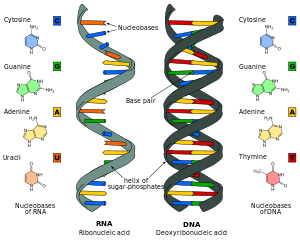
Back فرضية عالم الحمض النووي الريبوزي Arabic РНК-свят Bulgarian আরএনএ বিশ্ব Bengali/Bangla Hipoteza o svijetu RNK BS Hipòtesi del món d'ARN Catalan RNA svět Czech Byd RNA Welsh RNA-verdenshypotesen Danish RNA-Welt-Hypothese German Hipótesis del mundo de ARN Spanish

The RNA world is a hypothetical stage in the evolutionary history of life on Earth, in which self-replicating RNA molecules proliferated before the evolution of DNA and proteins.[1] The term also refers to the hypothesis that posits the existence of this stage.
Alexander Rich first proposed the concept of the RNA world in 1962,[2] and Walter Gilbert coined the term in 1986.[3] Alternative chemical paths to life have been proposed,[4] and RNA-based life may not have been the first life to exist.[3][5] Even so, the RNA world hypothesis seems to be the most favored abiogenesis paradigm, but even proponents agree it still has not reached conclusive evidence to completely falsify other paradigms and hypotheses.[2][6][7] The concurrent formation of all four RNA building blocks further strengthened the hypothesis.[8] Regardless of its plausibility in a prebiotic scenario, the RNA world can serve as a model system for studying the origin of life.[9]
- Like DNA, RNA can store and replicate genetic information.
- Like protein enzymes, RNA enzymes (ribozymes) can catalyze (start or accelerate) chemical reactions that are critical for life.[10]
One of the most critical components of cells, the ribosome, is composed primarily of RNA. Ribonucleotide moieties in many coenzymes, such as acetyl-CoA, NADH, FADH, and F420, may be surviving remnants of covalently bound coenzymes in an RNA world.[11]
Although RNA is fragile, some ancient RNAs may have evolved the ability to methylate other RNAs to protect them.[12]
If the RNA world existed, it was probably followed by an age characterized by the evolution of ribonucleoproteins (RNP world),[3] which in turn ushered in the era of DNA and longer proteins. DNA has greater stability and durability than RNA; this may explain why it became the predominant information storage molecule.[13] Protein enzymes may have come to replace RNA-based ribozymes as biocatalysts because their greater abundance and diversity of monomers makes them more versatile. As some cofactors contain both nucleotide and amino-acid characteristics, it may be that amino acids, peptides and finally proteins initially were cofactors for ribozymes.[11]
- ^ Johnson, Mark (9 March 2024). "'Monumental' experiment suggests how life on Earth may have started". The Washington Post. Archived from the original on 9 March 2024. Retrieved 10 March 2024.
- ^ a b Neveu M, Kim HJ, Benner SA (April 2013). "The "strong" RNA world hypothesis: fifty years old". Astrobiology. 13 (4): 391–403. Bibcode:2013AsBio..13..391N. doi:10.1089/ast.2012.0868. PMID 23551238.
[The RNA world's existence] has broad support within the community today.
- ^ a b c Cech TR (July 2012). "The RNA worlds in context". Cold Spring Harbor Perspectives in Biology. 4 (7): a006742. doi:10.1101/cshperspect.a006742. PMC 3385955. PMID 21441585.
- ^ Patel BH, Percivalle C, Ritson DJ, Duffy CD, Sutherland JD (April 2015). "Common origins of RNA, protein and lipid precursors in a cyanosulfidic protometabolism". Nature Chemistry. 7 (4): 301–307. Bibcode:2015NatCh...7..301P. doi:10.1038/nchem.2202. PMC 4568310. PMID 25803468.
- ^ Robertson MP, Joyce GF (May 2012). "The origins of the RNA world". Cold Spring Harbor Perspectives in Biology. 4 (5): a003608. doi:10.1101/cshperspect.a003608. PMC 3331698. PMID 20739415.
- ^ Wade, Nicholas (May 4, 2015). "Making Sense of the Chemistry That Led to Life on Earth". The New York Times. Archived from the original on July 9, 2017. Retrieved May 10, 2015.
- ^ Copley SD, Smith E, Morowitz HJ (December 2007). "The origin of the RNA world: co-evolution of genes and metabolism". Bioorganic Chemistry. 35 (6): 430–443. doi:10.1016/j.bioorg.2007.08.001. PMID 17897696.
The proposal that life on Earth arose from an RNA World is the one most researched in the topic of Abiogenesis.
- ^ Becker S, Feldmann J, Wiedemann S, Okamura H, Schneider C, Iwan K, et al. (October 2019). "Unified prebiotically plausible synthesis of pyrimidine and purine RNA ribonucleotides". Science. 366 (6461): 76–82. Bibcode:2019Sci...366...76B. doi:10.1126/science.aax2747. PMID 31604305. S2CID 203719976.
- ^ Pressman A, Blanco C, Chen IA (October 2015). "The RNA World as a Model System to Study the Origin of Life". Current Biology. 25 (19): R953–R963. Bibcode:2015CBio...25.R953P. doi:10.1016/j.cub.2015.06.016. PMID 26439358. S2CID 43793294.
- ^ Zimmer, Carl (September 25, 2014). "A Tiny Emissary from the Ancient Past". The New York Times. Archived from the original on September 27, 2014. Retrieved September 26, 2014.
- ^ a b White HB 3rd (1976). "Coenzymes as fossils of an earlier metabolic state". J Mol Evol. 7 (2): 101–104. Bibcode:1976JMolE...7..101W. doi:10.1007/BF01732468. PMID 1263263. S2CID 22282629.
- ^ Rana AK, Ankri S (2016). "Reviving the RNA World: An Insight into the Appearance of RNA Methyltransferases". Frontiers in Genetics. 7: 99. doi:10.3389/fgene.2016.00099. PMC 4893491. PMID 27375676.
- ^ Garwood RJ (2012). "Patterns In Palaeontology: The first 3 billion years of evolution". Palaeontology Online. 2 (11): 1–14. Archived from the original on June 26, 2015. Retrieved June 25, 2015.
© MMXXIII Rich X Search. We shall prevail. All rights reserved. Rich X Search